Using blackjack to raise the dead
Exploring Necromancer Heretic by Junk Food Games and how traditional games can be modified and recontextualized as the basis for modern board games and TTRPGs.
We’ve looked at quite a few board games recently including huge babies, painful choices, mythic battles, and mysterious aliens.
This week we return to TTRPGs with a solo journaling game by Junk Food Games that I picked up at the Indie & Local Tabletop Games Fair — Necromancer Heretic.
Necromancer Heretic
In Necromancer Heretic (PDF) by Junk Food Games (Moon Rings, Death Cap Sauté), you are a sorcerer.1 Your love, the Prince, has been executed and you have been banished from the kingdom. You are now attempting to resurrect the Prince and escape before the guards break through your barriers and stop you.
It is a solo journaling game, so each turn the player will be drawing and playing cards but also responding to story prompts: “Describe the last time you saw the Prince. Do you have any regrets?” or “You hear the guards outside cursing your name. How do you respond?”
The slim zine outlines the story, rules, and prompts for the game. The art is by Charles Ferguson-Avery of Feral Indie Studio.2
Blackjack as a core mechanism
The game can be divided into two parts:
Draw and play cards to attempt to gain 5 ritual points (i.e. resurrect the Prince) before you take 10 Damage.
Select and respond to text prompts regarding the past, present, and future.
Each round, the player can either draw cards from their supply into their hand or use cards for their special abilities. Then cards are added to three guard hands. Damage is taken and then finally a journal entry is completed. Play then continues by drawing new cards.
The core mechanism of the game is similar to blackjack with the goal of creating hands of cards that add up to 21. Number cards are worth their face value. Face cards are worth 10 and aces are either 1 or 11.3
Each time your hand reaches 21, you gain one of the five ritual points needed to win the game. Each time one of the three guard hands reaches 21, however, you take a point of damage. Hands are always immediately discarded when they reach 21 or higher.
Adding choices to journaling games
Many journaling games have limited player agency and mostly rely on rolling dice or drawing a card to determine the story prompt. Necromancer Heretic combines this with structured mechanisms that support player agency:
Prepare phase: You can select two actions including moving cards from your supply to the guards and/or using a card for a special power.
Cast phase: You can optionally draw a card from the top of the deck to add to your hand. It’s risky, but you gain Noct’s Blessing if it causes you to hit 21.
The game uses a mixture of open information (i.e. your supply of face up cards, your hand, and the guard hands) and hidden information (i.e. the face down draw deck). This allows some strategy to be used: choosing to draw lower or higher card values, deciding when to send cards to the guard hands, and trying to line up a 21.
At the center of the game, however, is the story. Whether you take damage or advance the ritual is what determines which prompts you respond to during the journaling phase. Taking damage will cause you to think about the past while advancing the ritual will have you dreaming about the future.4
Using traditional game mechanisms
Using blackjack as the basis for a solo journaling game is an example of taking a traditional game and recontextualizing it. Other games can be reused in similar ways, as I covered during Dice Week a couple years ago:
Day 1: Pig could be used for a “power up” magic system.
Day 2: Liar’s Dice for investigations and data gathering.
Day 3: Midnight to make a cyberpunk hacking system.
Day 4: Ship, Captain, and Crew for a stealth mechanism.
Day 5: Crown and Anchor was used in the Hellwhalers TTRPG.
Games like blackjack, poker, and most dice games have the advantages of using common components (dice and cards) and being familiar to most people. They can then be modified as necessary, for example how Necromancer Heretic allows clubs and diamonds to be played for special powers.
Did you know you can read Skeleton Code Machine on the web? Every one of the 110+ posts are in the archive. If you aren’t sure where to start, start here!
Conclusion
Some things to think about:
Start with the hook: “You are a sorcerer who wishes to bring your lover back from the dead,” is the pitch for Necromancer Heretic right on the back of the zine. It’s tempting to lead with background and lore when making a TTRPG zine, but you have precious little time to capture someone’s attention. Tell me what I’m doing and what role I will play.
Journaling plus: Some journaling games are meant to be a relaxing experience. They offer little to no mechanical choice and instead the fun comes from the writing and journaling (e.g. You are a Muffin).5 Other games add to this genre by having the mechanical portion of the game determine the story prompts (e.g. Necromancer Heretic) or have the selection of prompts impact the mechanical game state (e.g. Caveat Emptor).6
Consider traditional games: The modification of traditional trick-taking games like hearts and whist has spawned a vast and popular genre of games: The Crew, Skull King, The Forest, and Sail just to name a few. When designing a game, consider how other traditional card and dice games might influence the design.
What do you think? Are traditional games a good source of inspiration for modern game designs? Are you a fan of thematic trick-taking games and other recontextualizations of traditional card and dice games?
— E.P. 💀
P.S. Tumulus 04 “Return to the sea.” is shipping now until the end of November. Subscribe and select it as one of your four, quarterly issues. On December 1 it will only be available as a full-price back issue while supplies last.
Skeleton Code Machine is a production of Exeunt Press. All previous posts are in the Archive on the web. Subscribe to TUMULUS to get more design inspiration. If you want to see what else is happening at Exeunt Press, check out the Exeunt Omnes newsletter.
Skeleton Code Machine and TUMULUS are written, augmented, purged, and published by Exeunt Press. No part of this publication may be reproduced in any form without permission. TUMULUS and Skeleton Code Machine are Copyright 2025 Exeunt Press.
For comments or questions: games@exeunt.press
Junk Food Games was a contributor to Tumulus Issue 04. In “Desperate Depths” you dive into the water and grasp in the darkness for treasures. Tumulus 04 is available now as part of a new Tumulus subscription and will be available as a back issue starting December 1, 2025. Be sure to select Tumulus 04 from the options for it to be included in your four, quarterly issues.
The Vast in the Dark: Expanded is also by Charlie Ferguson-Avery and is one of my favorite TTRPG books. It’s packed with great art and depth crawl inspiration.
When played into a guard hand, the value is whichever gets the hand closer to 21. Unfortunately in the first draw of my first game of Necromancer Heretic I drew an ace for a guard. The next draw was a 10, resulting in an immediate 21 and taking 1 damage.
Interestingly, if you have note received damage or advanced the ritual during a given turn, you are forced to take a damage. With only 10 damage allowed before ending the game, this acts as a timer on the game, eventually forcing it to end. Ever since writing about timers or clocks in games in the context of Knarr, I’ve come to the conclusion that almost all games are better with one added.
For more about games and if they need player agency or not, check out The Carta SRD and Player Agency from 2024.
I wanted to provide incentives for players to choose “tougher” prompts when playing Caveat Emptor. You can read my thoughts about this in The curious case of Albrecht Bluome that I wrote as a follow-up to Beyond Solitaire’s excellent overview video.

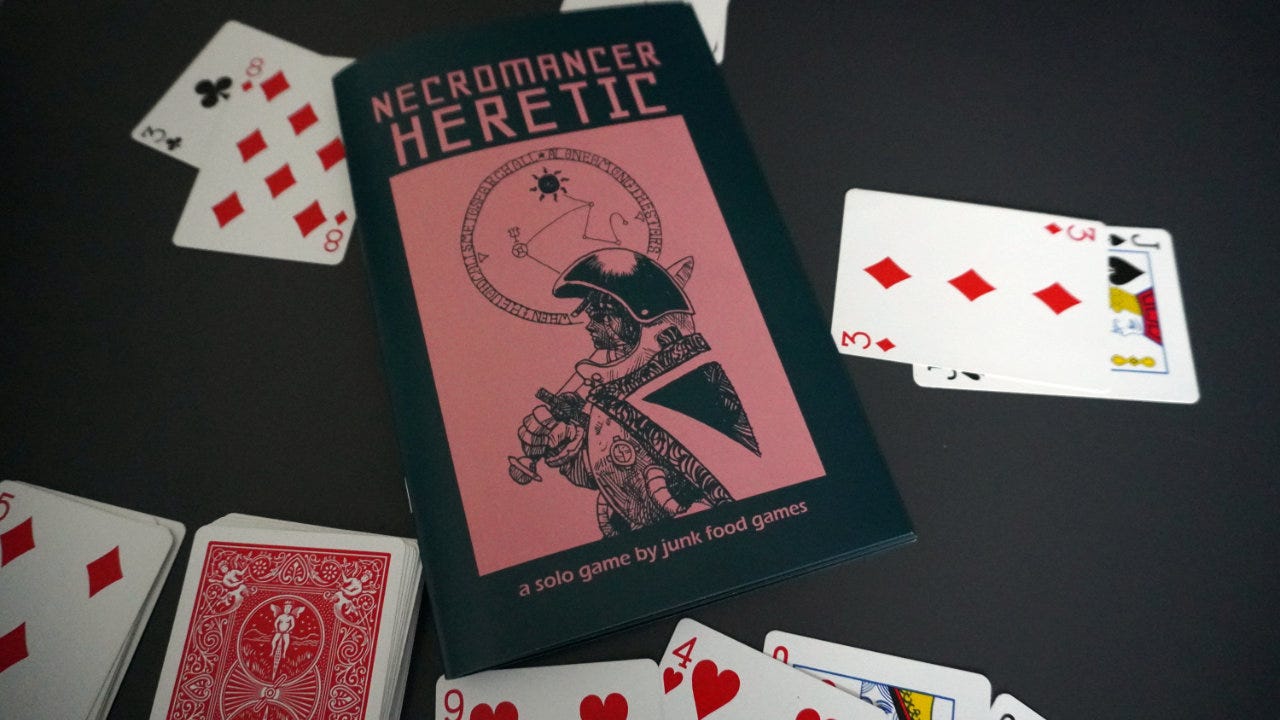
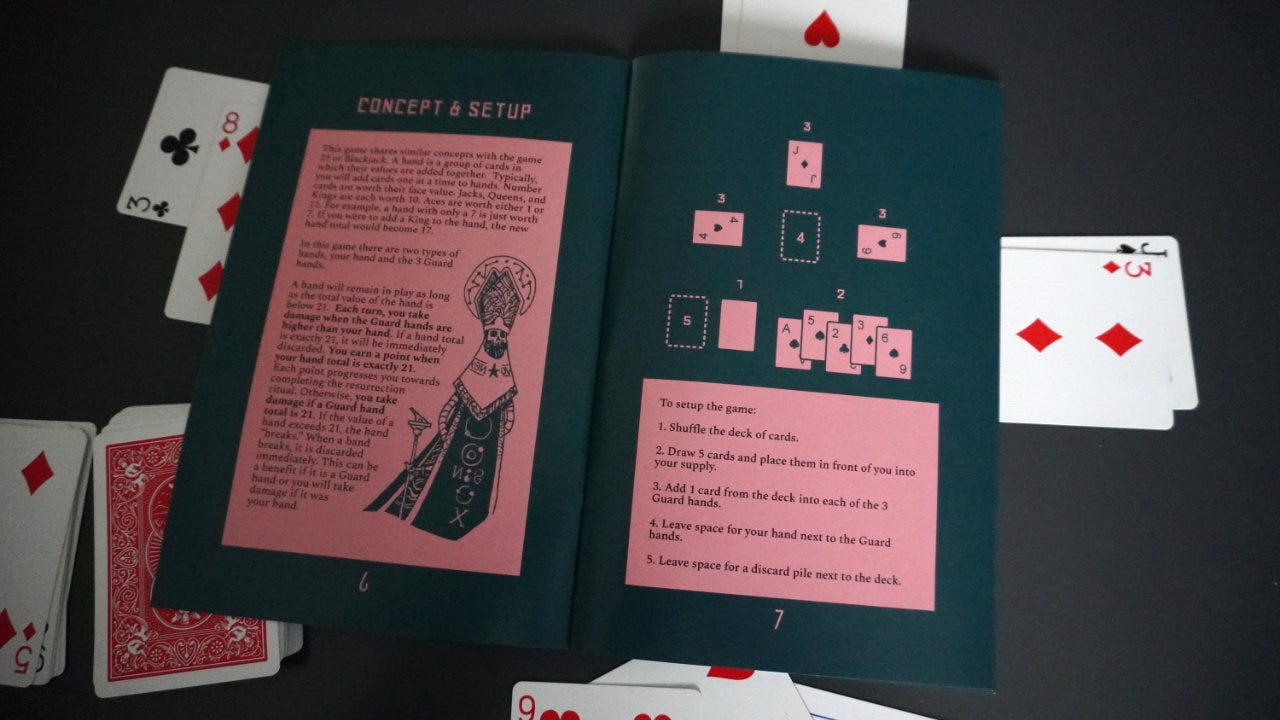
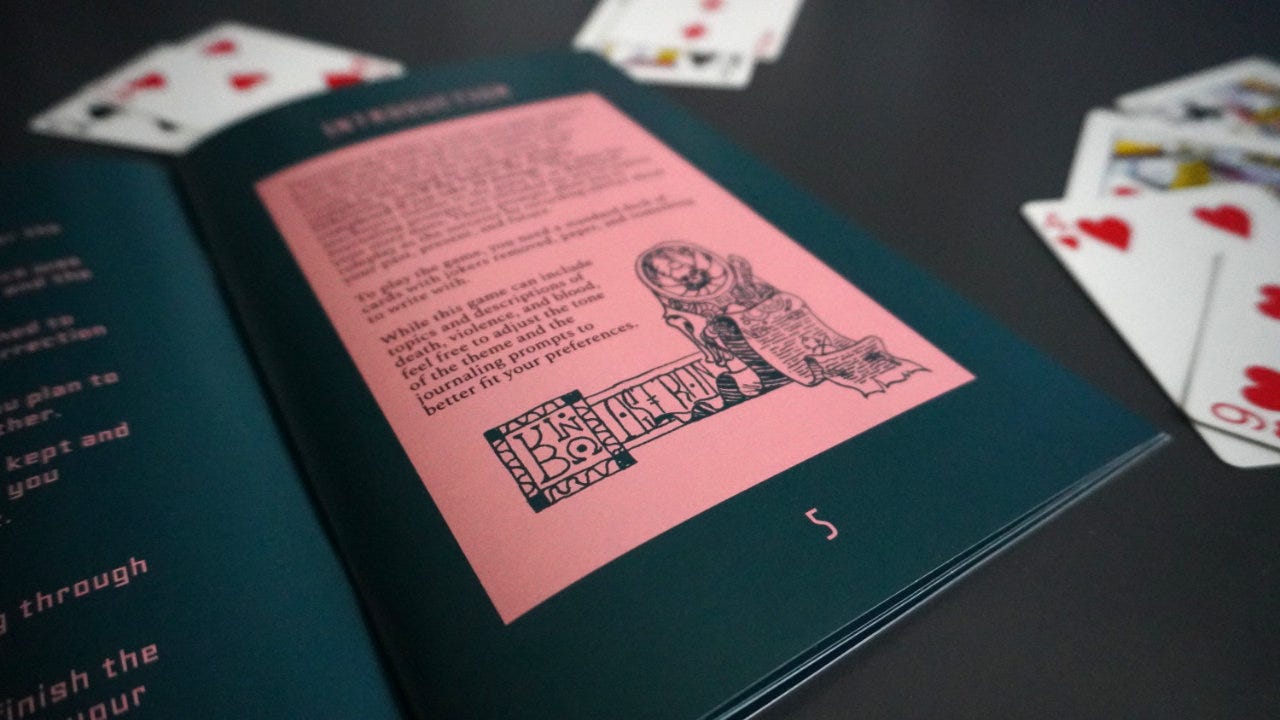
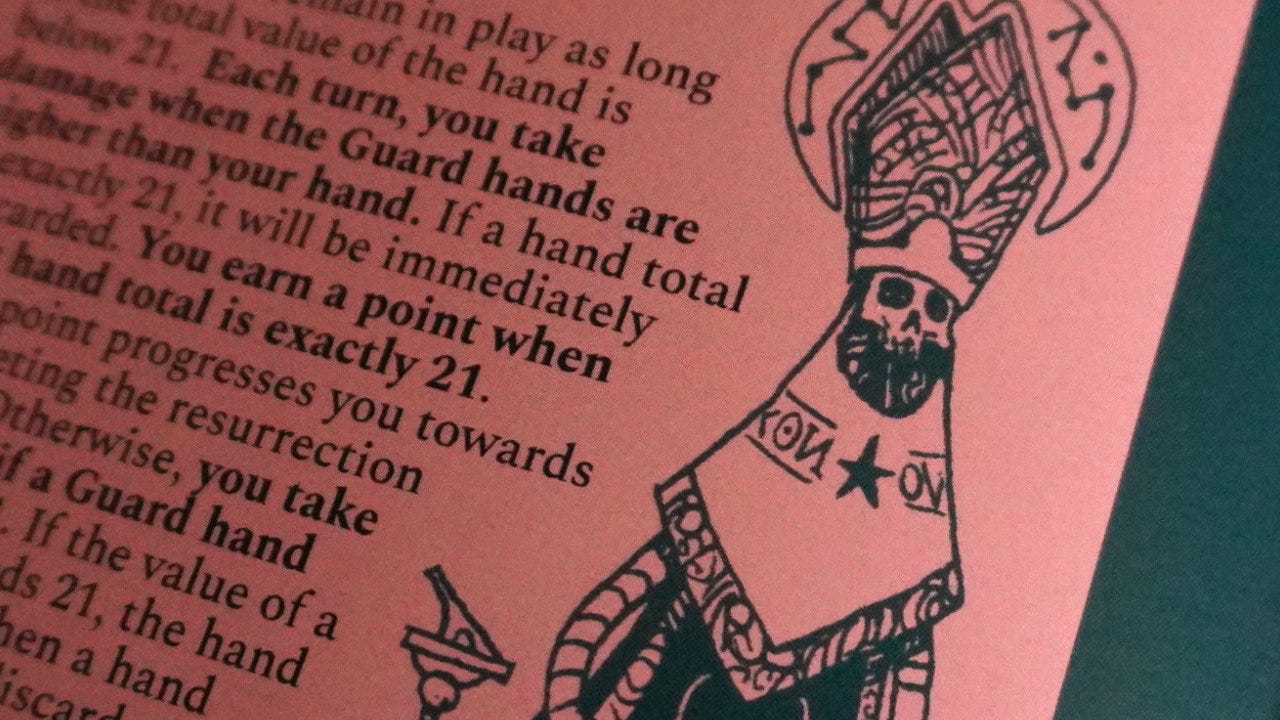
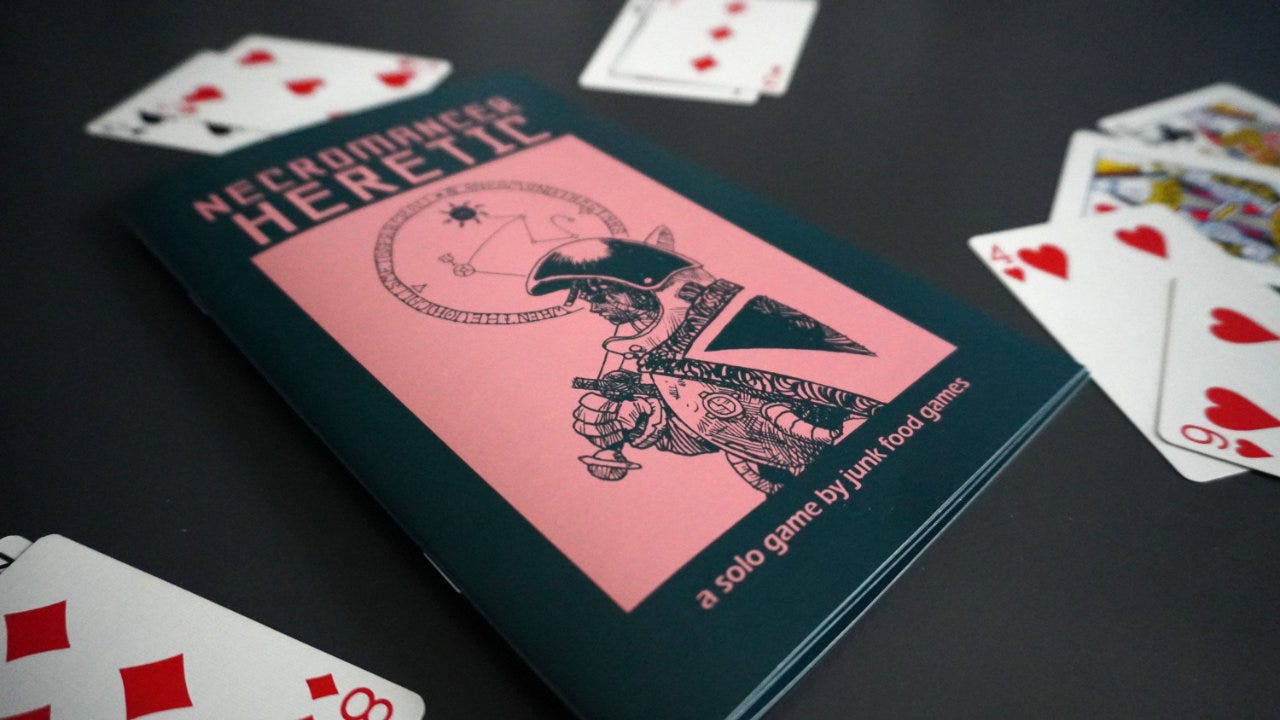
When I taught game studies at Loyola, my favorite assignment was having students modify the classic card game War to introduce player agency. It was cool to see how they all thought of player agency.
seems like a really cool game! i love the premise/pitch :) i love hearing about all these interesting mechanics, and find the cross-pollination between different genres of games especially neat :3 i voted for the category with whist, because that was a game i played growing up, whereas i didn't play poker nor blackjack ^^ so, more familiarity than what has most potential perhaps – and also because i couldn't choose otherwise, i really think all games have a lot of potential in inspiring new things :D i could've maybe went with dice games though, as someone who played a ton of yahtzee growing up as well ^^ thank you for sharing and writing <3